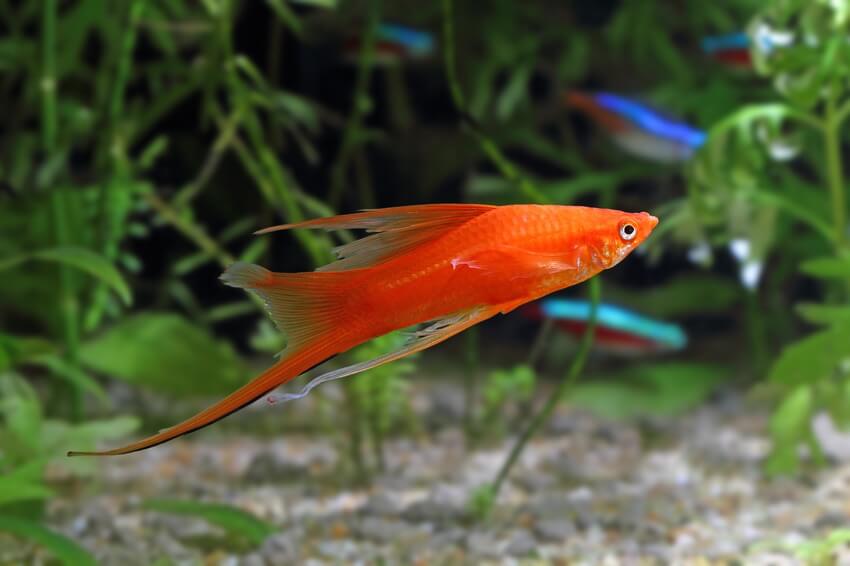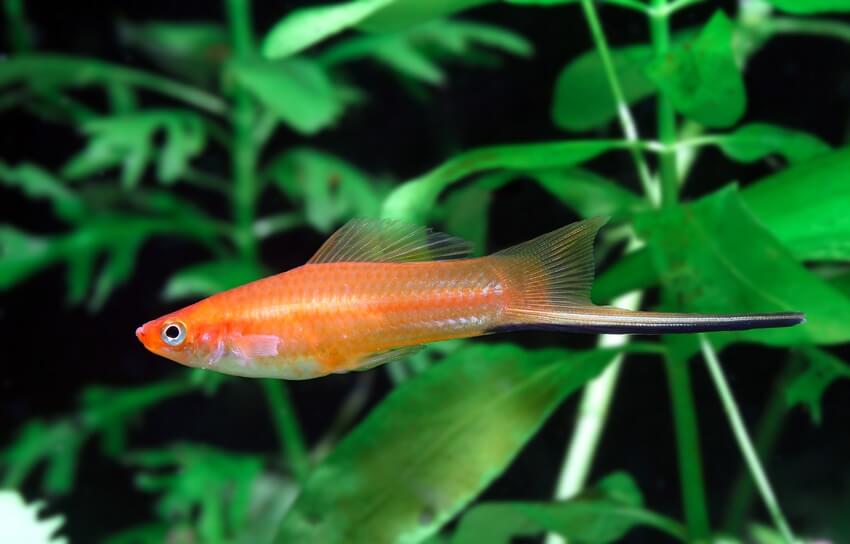Swordtail fish are a lovely and popular freshwater species in the aquarium community. Due to their beauty and low-maintenance nature, these fish make great choices for beginners (or experts who don’t want any hassle).
This guide will teach you the essentials of swordtail fish care. You’ll learn about their diet, lifespan, size, tank mates, habitat setup, and more!
Table of Contents
Species Summary
Swordtail fish (Xiphophorus helleri) are an ever-popular freshwater species that come from North and Central America. They belong to the Poeciliidae family and are closely related to other common fish like the platy and guppy. Like others in the Poeciliidae family, these fish are prolific livebearers who are more than willing to spawn in captivity (more on that later).
In the aquarium trade, swordtail fish are some of the most widely sold. They’re readily available at most pet stores and are a favorite among breeders.

Thanks to their penchant for cross-breeding and ease of care, many different colors and variations exist. Pair that with their already iconic look, and you have a species that’s ripe for display!
Appearance
The most defining feature of the swordtail fish is the male’s caudal fin. The lower lobe is elongated, creating a sword-like protrusion that can be just as long as the rest of the body.
Author Note: Females don’t have the longer lobe, so it’s easy to differentiate the sexes for breeding.
Beyond that signature trait, swordtail fish have a very “standard” body type! They look strikingly similar to the Southern platy. Swordtails are sporting the same streamlined body, wide tailfin, pointy snout, and upturned mouth. The fish are widest where the dorsal and pelvic fins appear at the midsection.
As for color, there’s a lot of variety! Wild specimens usually have an olive-green base and a brown lateral stripe that runs through the sword. However, cross-breeding has given aquarists all kinds of unique aesthetic options.
Some of the most widespread morphs are red, orange, and black. However, multi-colored swordtail fish and exotic varieties with distinct patterns exist as well.
Lifespan
The average swordtail fish lifespan is around three to five years. Fish kept in the best and most stable living conditions tend to live longer.
There’s no way to predict this for sure, as luck and genetic predispositions can impact a swordtail fish’s lifespan. That said, the level of care you provide will have a big impact on this.
Average Size
These are medium-sized freshwater fish. The average swordtail fish size is around 5.5 inches in length when fully grown.
Author Note: Males are the smallest of the bunch despite the elongated tail. They rarely exceed the length listed above. On the other hand, females often grow about an inch bigger!
Swordtail Fish Care
Swordtail fish care is pretty simple since these fish are adaptable and not very demanding. In other words, they’re easy to keep healthy! They thrive in a wide range of environments and are very forgiving to common beginner mistakes.
Of course, these fish still have their preferences. For the best results, stick to the established care guidelines below.
Tank Size
The first thing to consider is the size of the aquarium. Some aquarists have seen success keeping swordtail fish in freshwater tanks that hold as little as 10 gallons.
However, most recommend starting with a minimum of 15 gallons. These fish are fairly active, and the extra space will do them good.
Now, keep in mind that a 15-gallon tank is best for a single swordtail fish. Chances are, you’re going to keep a small group! Larger groups are better for their social development (more on that later).
If that’s the case, aim for a 30-gallon aquarium or larger. Larger tanks are always better for groups or if you’re planning on keeping a bunch of community fish together.
Water Parameters
The natural distribution of the swordtail in the wild is surprisingly broad. Generally, these freshwater fish live in warm streams and rivers with tons of vegetation. While they come from many places in North and Central America, they’re most prevalent in Belize, Guatemala, and Mexico.

Interestingly enough, swordtail fish can live in virtually any environment with fresh water. Whether it’s a shallow mountain creek or a deep river, they’ll adapt. Swordtails can even thrive in brackish estuaries near the coast!
This adaptive lifestyle is partly why swordtail fish care is such a simple task. You have a generous range of conditions with ample wiggle room to get things just right!
- Water temperature: 65°F to 82°F (75 to 79 degrees seems to be the sweet spot)
- pH levels: 7.0 to 8.4 (slightly alkaline)
- Water hardness: 12 to 35 dGH (very hard)
How To Decorate Their Tank
The best course of action for any fish is to provide a natural biotope setup that mimics its natural environment. Once again, the swordtail’s versatility makes this a pretty easy job.
The most important things that swordtail fish need are space and some plants for hiding.
This species is active and likes to swim across the tank for exercise and play. They tend to stick to the middle and upper parts of the water column. As a result, being picky about the substrate material is not something you need to think about when it comes to your swordtail fish. Instead, choose one that’s suitable for any bottom feeders you might have in the community.
You can use larger rock caves or driftwood to create some additional forms of shelter. However, there’s no guarantee that your swordtail fish will use it. This is especially true if the decor is close to the bottom of the tank.
It’s better to focus on plants. You can use either live or artificial silk plants. Live plants will do more to enhance the underwater environment.
You can use any plant that’s safe and provides adequate coverage. Some of the most popular cultivars are Java fern, Anubias, and dwarf hairgrass. Just make sure to leave open space for swimming.
Author Note: Other than some plants and hiding space, the only other crucial accessory is a strong tank lid! Swordtail fish are powerful jumpers, so it’s not uncommon to see these fish leap from the water to their death below. A secure lid will prevent those mishaps!
Common Possible Diseases
Like other livebearer species, swordtail fish are very hardy. They tend to have an easier time staying healthy than other egg-laying fish.
But of course, no fish is immune to disease! Swordtail fish can suffer from all the common ailments.
Ich is one of the most widespread health issues in the fish-keeping world. It’s an ectoparasite that ravages a fish’s immune system. Typically manifesting itself as white dots all over the body, it’s important to address it as soon as possible.
This disease is highly contagious and can quickly wipe out an entire community. Fortunately, it’s relatively easy to treat with quarantining and over-the-counter medications.
The same goes for another common health issue, fungus. Swordtails can suffer from a fungal infection that many refer to as cottonmouth. It causes fluffy growth around the fins and mouth. In most cases, antibiotics will take care of fungi.
The best way to avoid disease is to stay on top of tank conditions. Monitor the parameters closely (invest in an aquarium test kit) and perform water changes every two weeks or so.
Author Note: Swordtail fish seem to fall prey to disease after major fluctuations in temperature. High levels of ammonia and nitrates can cause undue stress, which increases their risks as well. Keeping the environment in tip-top shape will prevent outbreaks.
Food & Diet
Swordtail fish are natural omnivores that eat just about anything in the wild. Bug larvae, plant detritus, and tiny microorganisms are usually the name of the game.
Swordtail fish do best with a varied diet of commercial food and occasional high-protein snacks in an aquarium setting. Stick to nutrient-rich flakes or pellets. To provide some plant-based cuisine, offer up algae wafers every once in a while.

These fish appreciate live, frozen, and freeze-dried foods as well. Brine shrimp, daphnia, bloodworms, and all the usual high-protein snacks all work.
Juveniles should have a little more protein than usual. They require lots of protein-based foods to grow.
For both adults and juveniles, two or three small meals a day is ideal. Provide enough food for your fish to eat in two minutes during each feeding. If there are any leftovers, sift them out to avoid ruining the water conditions.
Behavior & Temperament
This species is fantastic for communities. One of the reasons why swordtail fish care is so manageable is that they’re naturally peaceful and quite friendly. During the day, they’ll interact with other fish while exploring the upper parts of the water column.
While not a shoaling species, swordtail fish prefer to stay in the company of others. These fish like to form groups periodically before going off and doing their own thing.
That said, there is the potential for some aggression. The only time swordtail fish seem to ever show aggressive behavior is when multiple males are in the same tank. Males can be territorial, so it’s important to maintain a higher ratio of females to keep the peace.
Tank Mates
Swordtail fish get along with most like-minded species. They’re peaceful and passive.
When planning a community tank, start by adding other swordtail fish. You should never keep these fish alone. A small group for socialization can do a lot of good!
As mentioned earlier, you must keep more females than males. The recommended ratio is four females to a single male.
Beyond other swordtail fish, you have a lot of options as far as tank mates go. Stick to similarly sized fish with the same easy-going temperament.
Avoid aggressive or boisterous fish. Swordtail fish cannot defend themselves from aggressors. In the presence of more active fish, they also become timid and shy.
The best course of action is to house them with common social fish. Here are some excellent species worth considering for swordtail fish tank mates:
- Platy Fish
- Molly Fish
- Angelfish
- Cory Catfish
- Rosy Barbs
- Dwarf Gouramis
- Neon Tetras
- Celestial Pearl Danios
- Kuhli Loaches
- Otocinclus
Breeding
Swordtail breeding is a straightforward process. Like other livebearers, they are quick to spawn in captivity. In the right conditions, females can give birth once every 28 days!
While they will readily breed in your primary tank without any intervention, it’s best to provide a separate breeding environment. A breeding tank increases the chances of survival for the fry.
Raise the temperatures of the breeding tank gradually to about 80 degrees. Place several fine-leaf plants throughout the aquarium to give the fry some places to hide.
Keep the tank conditions in good shape and condition your breeding pair with high-protein foods. When they’re ready, the fish will spawn. Females will start to swell with eggs as a visible gravid spot develops.
Generally, pregnant females go to one corner of the tank and stay there as she gets closer to giving birth. Eventually, the fully-formed swordtail fry will emerge!
Author Note: Make sure to remove the adults after the female gives birth. These fish exhibit no parental instincts and will immediately try to eat their young.
Fish fry are too small to eat standard flakes or pellets. So, you must provide powdered fish food, infusoria, or freshly hatched brine shrimp. Continue feeding the fish until they are big enough to eat traditional foods.
Wrapping Up
As you can probably tell, swordtail fish care is nothing to be afraid of. These freshwater fish are a pleasure to own and shouldn’t cause any trouble.
As long as you’re familiar with their baseline care requirements and give them the attention they deserve, your swordtails will thrive.
We hope this guide was helpful and encouraged you to give this amazing species a chance!

